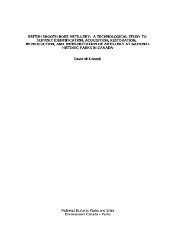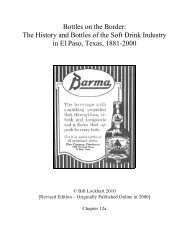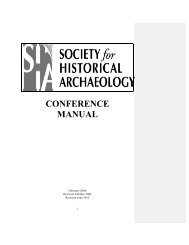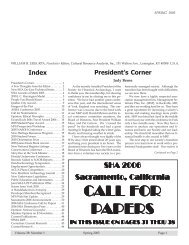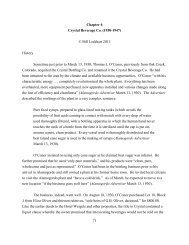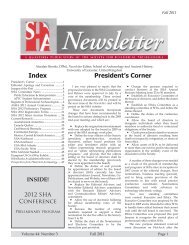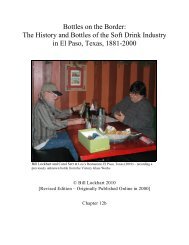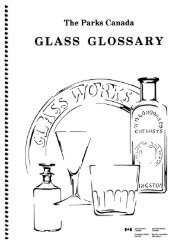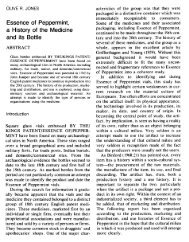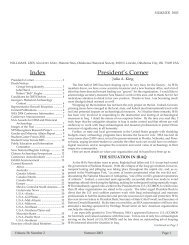Bottles on the Border: The History and Bottles of the Soft Drink ...
Bottles on the Border: The History and Bottles of the Soft Drink ...
Bottles on the Border: The History and Bottles of the Soft Drink ...
Create successful ePaper yourself
Turn your PDF publications into a flip-book with our unique Google optimized e-Paper software.
<str<strong>on</strong>g>Bottles</str<strong>on</strong>g> <strong>on</strong> <strong>the</strong> <strong>Border</strong>:<br />
<strong>The</strong> <strong>History</strong> <strong>and</strong> <str<strong>on</strong>g>Bottles</str<strong>on</strong>g> <strong>of</strong> <strong>the</strong> S<strong>of</strong>t <strong>Drink</strong> Industry<br />
in El Paso, Texas, 1881-2000<br />
John Yowel (st<strong>and</strong>ing) with s<strong>on</strong> “Dub” (in truck), 1959 (Courtesy <strong>of</strong> Joe W. Yowell)<br />
© Bill Lockhart 2010<br />
[Revised Editi<strong>on</strong> – Originally Published Online in 2000]<br />
Chapter 11c
Chapter 11c<br />
Later Dr Pepper Companies<br />
Barq’s Dr Pepper Bottling Co. (1957-1976)<br />
<strong>History</strong> 1 In 1957, <strong>the</strong> Yowells bought <strong>the</strong> Dr Pepper<br />
franchise, changing <strong>the</strong> name to Barq’s Dr Pepper<br />
Bottling Co. <strong>The</strong> defunct Dr Pepper plant <strong>on</strong><br />
Highway 80 was ab<strong>and</strong><strong>on</strong>ed in favor <strong>of</strong> <strong>the</strong> Barq’s<br />
1315 West Main Dr. locati<strong>on</strong>, closer to <strong>the</strong> center <strong>of</strong><br />
town (Figures 11c-1 & chapter cover page). John<br />
Yowell had a stroke in 1960 that left him partially<br />
paralyzed <strong>and</strong> c<strong>on</strong>fined to a wheelchair. He died in<br />
1967, leaving his wife, Mari<strong>on</strong>, <strong>and</strong> s<strong>on</strong>, Joe, to run<br />
<strong>the</strong> operati<strong>on</strong> (EPCD 1957-1967).<br />
Figure 11c-1 – Unpacking Dr Pepper<br />
bottles made by Liberty Glass Co. in 1958<br />
(Courtesy <strong>of</strong> Joe W. Yowell)<br />
Joe W. “Dub” Yowell, born in 1931 <strong>and</strong> raised in <strong>the</strong> bottling business, took <strong>on</strong> ever<br />
greater resp<strong>on</strong>sibilities. <strong>The</strong> company obtained Squirt <strong>and</strong> Dad’s Root Beer from Empire in 1969<br />
<strong>and</strong> were selling Dr Pepper <strong>and</strong> Lipt<strong>on</strong>’s Iced Tea in cans by 1970 (Figure 11c-2). <strong>The</strong> firm<br />
c<strong>on</strong>tinued to grow <strong>and</strong> exp<strong>and</strong>. At <strong>the</strong> company’s peak, Barq’s trucks ran from Van Horn, Texas,<br />
in <strong>the</strong> east to Lordsburg, New Mexico, in <strong>the</strong> west <strong>and</strong> northward into Silver City, Alamogordo,<br />
<strong>and</strong> Ruidoso. To keep up with <strong>the</strong> business, Yowell installed warehouses in Van Horn, Silver<br />
City, <strong>and</strong> Alamogordo (EPCD 1957-1976; EPTD 1970).<br />
It was too much territory <strong>and</strong> brought unwanted problems to Yowell. During World War<br />
II, <strong>on</strong>e truck failed to come back from <strong>the</strong> New Mexico route. <strong>The</strong> sheriff at Truth or<br />
C<strong>on</strong>sequences called Yowell to tell him that <strong>the</strong> truck was sitting <strong>on</strong> its break drums in an alley.<br />
<strong>The</strong> driver had sold all <strong>the</strong> drinks <strong>and</strong> even <strong>the</strong> truck tires, <strong>the</strong>n fled <strong>the</strong> state (Yowell’s<br />
1<br />
Unless o<strong>the</strong>rwise cited, most <strong>of</strong> this informati<strong>on</strong> came from a series <strong>of</strong> interviews with<br />
“Dub” Yowell.<br />
525
predecessor had experienced<br />
similar troubles–see above). That<br />
was enought for Yowell. <strong>The</strong><br />
income from <strong>the</strong> additi<strong>on</strong>al territory<br />
no l<strong>on</strong>ger exceeded <strong>the</strong> cost in<br />
frustrati<strong>on</strong>. In <strong>the</strong> late 1960s, he<br />
turned over most <strong>of</strong> <strong>the</strong> New<br />
Mexico Dr Pepper business to Joe<br />
W. Wolslager <strong>of</strong> <strong>the</strong> Coca-Cola Co.<br />
<strong>of</strong> San Angelo, Texas.<br />
<str<strong>on</strong>g>Bottles</str<strong>on</strong>g><br />
Barq’s Flavors – 12 Ounce<br />
Figure 11c-2 –Leisure time at a c<strong>on</strong>venti<strong>on</strong> - (left to right) Joe<br />
W. “Dub” Yowell; Bob Ranselm (Barq’s Sales Manager); Jim<br />
Larabel (Pepsi-Cola, El Paso); <strong>and</strong> <strong>the</strong> unidentified manager <strong>of</strong><br />
Pepsi-Cola in Las Cruces (Courtesy <strong>of</strong> Joe W. Yowell)<br />
For c<strong>on</strong>tinuity, <strong>the</strong> bottles used by <strong>the</strong> Barq’s Dr Pepper Bottling Co. were addressed in<br />
Chapter 11b. At this point, I have recorded two 12-ounce Barq’s bottles, <strong>on</strong>e from 1960, <strong>the</strong><br />
o<strong>the</strong>r probably from <strong>the</strong> early 1960s – both <strong>of</strong> which still had <strong>the</strong> local city/state designati<strong>on</strong>.<br />
However, both bottles were still marked “BARQ’S BOTTLING CO. / EL PASO, TEXAS.”<br />
Why Yowell c<strong>on</strong>tinued to use <strong>the</strong> old name is unknown. <strong>The</strong> reas<strong>on</strong> may be as simple as<br />
forgetting to tell <strong>the</strong> glass house to change <strong>the</strong> name.<br />
Barq’s Flavors – 16-ounce<br />
Barq’s also used at least two 18-ounce bottles. <strong>The</strong>se were made in <strong>the</strong> same specialty<br />
style as <strong>the</strong> 12-ounce <strong>and</strong> smaller bottles <strong>and</strong> were embossed with <strong>the</strong> same patent number. <strong>The</strong><br />
bottles were made in at least two sub-variati<strong>on</strong>s used at El Paso. Although both were <strong>the</strong> same<br />
capacity, <strong>on</strong>e was marked ONE PINT / 2 OZS. <strong>on</strong> <strong>the</strong> neck (Figure 11c-3), <strong>the</strong> o<strong>the</strong>r 18 oz.<br />
Method <strong>of</strong> Manufacture: Machine<br />
Color: Colorless<br />
Size (in cm.): 29.5 (h); 6.6 (d)<br />
Primary Labeling Style: White <strong>and</strong> Blue ACL<br />
Finish: Crown<br />
526
Capacity: 18 oz.<br />
Overall Bottle Design: Cylindrical with swelled neck<br />
(similar to beer bottles, supposedly to allow for foam<br />
expansi<strong>on</strong>); body <strong>and</strong> neck embossed with orange peel<br />
design<br />
Fr<strong>on</strong>t Descripti<strong>on</strong><br />
Neck: White ACL - ONE PINT / 2 OZS.18 OZ.<br />
Shoulder: Embossed with <strong>of</strong>fset checkerboard design<br />
extending into body with inset at upper body embossed<br />
with CONT. 18 FL. OZS.<br />
Body: A white border with blue backgrounds at top<br />
<strong>and</strong> bottom. Within <strong>the</strong> blue background was <strong>the</strong> word,<br />
DRINK, followed by Barq’s (upwardly slanted script in<br />
<strong>the</strong> colorless background) / TRADE MARK REG.<br />
(upwardly slanted in <strong>the</strong> colorless background) <strong>and</strong>,<br />
IT’S GOOD in <strong>the</strong> lower blue secti<strong>on</strong> / ONE PINT 2<br />
OZS. (white – below <strong>the</strong> rectangular label)<br />
Back Descripti<strong>on</strong><br />
Neck: Same as fr<strong>on</strong>t<br />
Shoulder: Same as fr<strong>on</strong>t but embossed: DESIGN<br />
PAT. D-98026 with Barq’s (script) / REG. below – in<br />
<strong>the</strong> upper-body secti<strong>on</strong><br />
Body: White ACL - CONTENTS ONE PINT 2 OZS. / PROPERTY OF / BARQ’S BOTTLING<br />
CO. / EL PASO, TEXAS<br />
Base: Embossed - 1460 / © 66 / 3 with stippling <strong>on</strong> entire base<br />
Manufacturer: Chattanooga Glass Co. (1925-present)<br />
Dating: [mid-1960s] Both 18-ounce examples I have seen were made in 1966. It is possible that<br />
1966 was <strong>the</strong> <strong>on</strong>ly year Barq’s tried this size. Sixteen-ounce bottles were first used in El Paso in<br />
<strong>the</strong> early 1960s (ca. 1962) by Vess <strong>and</strong> 3-V Cola. O<strong>the</strong>r bottlers so<strong>on</strong> followed suit. <strong>The</strong>se<br />
bottles are unusual, however, because most franchises had ceased placing bottler’s names <strong>on</strong> <strong>the</strong><br />
bottles by ca. 1960.<br />
Collecti<strong>on</strong>(s): Author’s collecti<strong>on</strong>.<br />
Figure 11c-3 – Larger size Barq’s bottle –<br />
ONE PINT 2 OZ<br />
527
Variati<strong>on</strong>s:<br />
1. Described above<br />
2. Although <strong>the</strong>se two bottles supposedly had <strong>the</strong><br />
same capacity, <strong>the</strong> 18-ounce variati<strong>on</strong> was slightly<br />
taller, measuring 29.7 cm. in height <strong>and</strong> 6.5-6.6 cm.<br />
in diameter. <strong>The</strong> bottle was o<strong>the</strong>rwise perfectly<br />
identical to Variati<strong>on</strong> 1 in c<strong>on</strong>figurati<strong>on</strong> <strong>and</strong><br />
embossing, except for a 1 in <strong>the</strong> mold code positi<strong>on</strong><br />
instead <strong>of</strong> a 3. <strong>The</strong> major differences were in <strong>the</strong><br />
ACL porti<strong>on</strong>. <strong>The</strong> neck was embossed 18 OZ. <strong>on</strong><br />
both sides. <strong>The</strong> fr<strong>on</strong>t label was <strong>the</strong> same but with no<br />
volume designati<strong>on</strong> under <strong>the</strong> rectangle. Below <strong>the</strong><br />
back embossing, <strong>the</strong> ACL proclaimed CONTENTS<br />
18 FL. OZS. but was o<strong>the</strong>rwise <strong>the</strong> same (Figure<br />
11c-4).<br />
Two bottles with exactly <strong>the</strong> same design but<br />
different ACL, made during <strong>the</strong> same year – by <strong>the</strong><br />
same glass house – for <strong>the</strong> same bottling plant, are<br />
unusual, to say <strong>the</strong> least! At a guess – <strong>and</strong> this is<br />
<strong>on</strong>ly speculati<strong>on</strong> – I would say that <strong>the</strong> 18 oz.<br />
variati<strong>on</strong> was tried first, without any notable<br />
increase in sales. Since 18 looks very similar to 16, Yowell may have thought that <strong>the</strong> drinking<br />
public did not realize <strong>the</strong> bottle held an extra two ounces. <strong>The</strong> ONE PINT / 2 OZS. variati<strong>on</strong><br />
emphasized <strong>the</strong> additi<strong>on</strong>al two ounces. Of course, <strong>the</strong> opposite is possible. A sizeable porti<strong>on</strong> <strong>of</strong><br />
<strong>the</strong> populati<strong>on</strong> may not have realized that ONE PINT was <strong>the</strong> same as 16 OZ., a designati<strong>on</strong> <strong>on</strong><br />
all <strong>the</strong> 16-ounce bottles.<br />
Figure 11c-4 – Larger size Barq’s bottle – 18<br />
OZ<br />
Dr Pepper – ACL<br />
Briefly (1954-55), Dr Pepper used a transiti<strong>on</strong> bottle with a clock face in red <strong>and</strong> white<br />
ACL <strong>on</strong> <strong>the</strong> bottle neck. <strong>The</strong> rest <strong>of</strong> <strong>the</strong> bottle c<strong>on</strong>tained <strong>the</strong> debossed labeling noted above.<br />
<strong>The</strong>se bottles are extremely rare (Mildred G. Walker, pers<strong>on</strong>al communicati<strong>on</strong>). In June, 1955,<br />
<strong>the</strong> company introduced <strong>the</strong> first bottles entirely decorated with enameled labels. <strong>The</strong>se Georgia<br />
528
Green c<strong>on</strong>tainers showed a white bottle cap <strong>on</strong> both shoulder <strong>and</strong> body<br />
fr<strong>on</strong>t. A red slanted bar stretched across <strong>the</strong> cap with <strong>the</strong> words Dr<br />
Pepper in white slanted block letters <strong>and</strong> ® under <strong>the</strong> third “P.” Above<br />
<strong>the</strong> bar was printed 10 drink 2 in red, with 4 below <strong>the</strong> bar. <strong>The</strong>se bottles<br />
were used between 1955 <strong>and</strong> 1960 but, like <strong>the</strong>ir predecessor, are<br />
extremely rare <strong>and</strong> may never have actually seen use in most jurisdicti<strong>on</strong>s<br />
(Ellis 1979:193, 201, 205, 258, 259).<br />
It is unlikely that ei<strong>the</strong>r <strong>of</strong> <strong>the</strong>se transiti<strong>on</strong><br />
bottles were used at El Paso. In Chapter 11a, I<br />
recorded <strong>on</strong>e <strong>of</strong> <strong>the</strong> green debossed bottles with a<br />
date code for 1957. This was almost certainly<br />
<strong>the</strong> last bottle ordered by <strong>the</strong> Dr Pepper Bottling<br />
Co. before Barq’s acquired <strong>the</strong> franchise. Barq’s<br />
almost certainly c<strong>on</strong>tinued to fill <strong>the</strong> older bottles<br />
until <strong>the</strong>y wore out.<br />
In 1958, <strong>the</strong> company selected a style it<br />
called “bounce lettering” to distinguish <strong>the</strong>ir<br />
third ACL bottle c<strong>on</strong>figurati<strong>on</strong>. <strong>The</strong> lettering<br />
was so named because <strong>the</strong> third “p” was “bounced” up to a slightly<br />
higher positi<strong>on</strong> than <strong>the</strong> o<strong>the</strong>r two (Figure 11c-5). Although <strong>the</strong> new<br />
style was introduced in 1958, <strong>the</strong> logo was not used until 1960. <strong>The</strong><br />
style c<strong>on</strong>tinued until 1971 (Ellis 1979:205, 260).<br />
Figure 11c-5 – Dr<br />
Pepper bottle with<br />
“bounce” letters –<br />
introduced in 1958<br />
(Willie Terrazas<br />
collecti<strong>on</strong>)<br />
Figure 11c-6 – Dr<br />
Pepper bottle with<br />
broad letters –<br />
introduced in 1971<br />
Ano<strong>the</strong>r style, in use from 1971, included broader letters <strong>and</strong><br />
eliminated <strong>the</strong> venerable clock that had l<strong>on</strong>g dominated Dr Pepper<br />
advertising (Figure 11c-6). By 1996, returnable bottles had virtually<br />
disappeared from grocery shelves, being replaced almost entirely by<br />
cans, plastic c<strong>on</strong>tainers, <strong>and</strong> n<strong>on</strong>-returnable glass bottles. A few<br />
individual bottlers c<strong>on</strong>tinue to use returnable bottles that were still available from Vitro<br />
Packaging Company <strong>of</strong> McAllen, Texas. <strong>The</strong>se few, however, represent <strong>the</strong> last holdouts at <strong>the</strong><br />
end <strong>of</strong> more than a century-old traditi<strong>on</strong> <strong>of</strong> <strong>the</strong> use <strong>of</strong> returnable bottles in s<strong>of</strong>t drink packaging.<br />
See Table 11a-2 for a chr<strong>on</strong>ology <strong>of</strong> Dr Pepper bottles.<br />
529
Table 11c-1 - Dr Pepper Bottle Chr<strong>on</strong>ology*<br />
Beginning Date<br />
1891-ca. 1907<br />
Descripti<strong>on</strong> <strong>of</strong> Bottle Change<br />
Blob top, round bottom, embossed<br />
1900-10 Crown finish, round bottom<br />
1907-12 Crown finish, machine-made, “King <strong>of</strong> Beverages” also “Thief”<br />
bottle<br />
1923-24 Crown finish, colorless, embossed, “Good for Life,” 3-h<strong>and</strong>ed clock<br />
ca. 1930<br />
Colorless, debossed, “Good for Life,” 3-h<strong>and</strong>ed clock<br />
1950 Georgia green, debossed, slant block lettering, no period after Dr, no<br />
h<strong>and</strong>s <strong>on</strong> clock<br />
1954-55 same, with ACL clock face <strong>on</strong> neck<br />
1955 ACL, bottle cap design, slant block lettering<br />
1955 ACL, clock design, no bottle cap, slant block lettering<br />
1960-61 ACL, bounce lettering (3rd “p” “bounced” up)<br />
1971 ACL, broad block lettering in oval, no clock<br />
* Informati<strong>on</strong> from pers<strong>on</strong>al communicati<strong>on</strong> with Mildred G. Walker, Curator, Dr Pepper<br />
Museum<br />
Dr Pepper Cans<br />
Dr Pepper first marketed 6-ounce, c<strong>on</strong>e-top or crown-cap cans <strong>on</strong> October 13, 1954,<br />
al<strong>on</strong>g with 10- <strong>and</strong> 12-ounce flat-top or punch-top cans. <strong>The</strong> following year (1955), two c<strong>on</strong>etop<br />
cans in 6- <strong>and</strong> 12- ounce sizes were <strong>of</strong>fered with <strong>the</strong> 10-2-4 clock as part <strong>of</strong> <strong>the</strong> design.<br />
<strong>The</strong>se lasted until <strong>the</strong> “c<strong>and</strong>y stripe” promoti<strong>on</strong> in 1958 which marked <strong>the</strong> end <strong>of</strong> c<strong>on</strong>e-top cans<br />
by Dr Pepper (Bates 200b).<br />
One <strong>of</strong> <strong>the</strong> major advantages <strong>of</strong> c<strong>on</strong>e-top cans was that <strong>the</strong>y could be filled by existing<br />
bottling equipment ra<strong>the</strong>r than an expensive retooling <strong>of</strong> <strong>the</strong> line for flat-top cans. Although I<br />
have never found a printed reference, <strong>and</strong> Joe Yowell never menti<strong>on</strong>ed it in his interviews, both<br />
530
<strong>the</strong> Dr Pepper Bottling Co. (1950-1956) <strong>and</strong> Barq’s Dr Pepper Bottling Co. (1957-1976) could<br />
have canned <strong>the</strong> beverage in c<strong>on</strong>e-top cans using regular bottling equipment. After 1958,<br />
however, canning would have required an entirely new line <strong>of</strong> equipment.<br />
Dr Pepper Shell<br />
In 1972, <strong>the</strong> Dr Pepper Bottling Company used a red<br />
shell (case) with white lettering. Each end board was lettered<br />
DR PEPPER BOTTLING CO / {10-2-4 clockface to both right<br />
<strong>and</strong> left <strong>of</strong> h<strong>and</strong> hole} / EL PASO, TEXAS (Figure 11c-7). <strong>The</strong><br />
outside <strong>of</strong> each side board was labeled DRINK / Dr Pepper / ®<br />
in broad lettering. <strong>The</strong> inside <strong>of</strong> each side board was labeled in<br />
red with DRINK / Dr Pepper (bounce lettering) / ® (logo<br />
comprising a broken circle with six spokes) / TEMPLE MFG<br />
Figure 11c-7 – End view <strong>of</strong> a<br />
1972 Dr Pepper shell<br />
CO / DALLAS, TEX. / 2 - 72. It is interesting that <strong>the</strong> inside <strong>of</strong> <strong>the</strong> shell is labeled with <strong>the</strong><br />
older lettering style, apparently utilizing old sideboards turned inward (Figure 11c-8).<br />
Figure 11c-8 – Side vew <strong>of</strong> a 1972 Dr Pepper<br />
shell, showing internal letters<br />
<strong>The</strong> wooden shell was made from two<br />
sideboards ca. 1 cm. thick, three base boards ca. 1.0<br />
cm. thick, <strong>and</strong> two end boards ca. 1.9 cm. thick.<br />
<strong>The</strong> boards were held toge<strong>the</strong>r with two 1.5 cm.<br />
thick steel b<strong>and</strong>s c<strong>on</strong>necting <strong>the</strong> base <strong>and</strong> side<br />
boards to <strong>the</strong> end boards with nails. <strong>The</strong> interior <strong>of</strong><br />
<strong>the</strong> shell was divided by two boards (ca. 0.7 cm.<br />
thick) into four even areas to c<strong>on</strong>tain sixpack<br />
cart<strong>on</strong>s <strong>of</strong> bottles. All measurements <strong>of</strong> wood vary<br />
slightly because <strong>of</strong> warping <strong>and</strong> wear.<br />
Dietetic Dr Pepper <strong>and</strong> Diet Dr Pepper<br />
Dietetic Dr Pepper was introduced in 1962, first in twelve-ounce cans, later (1963) in six<strong>and</strong>-a-half-,<br />
ten-, <strong>and</strong> twelve-ounce returnable bottles. <strong>The</strong> bottle shape was unique. From <strong>the</strong><br />
heel, <strong>the</strong> body pinched in slightly, <strong>the</strong>n extended vertically upward to a point just below <strong>the</strong><br />
shoulder. At that point, <strong>the</strong> sides dipped sharply in to form a horiz<strong>on</strong>tal countersunk ring around<br />
531
<strong>the</strong> bottle. A gradually sloping shoulder <strong>and</strong> neck <strong>the</strong>n led up to <strong>the</strong> finish. <strong>The</strong> name, Dr<br />
Pepper, with <strong>the</strong> ® under <strong>the</strong> third “P” was superimposed <strong>on</strong> a white oval above <strong>the</strong> word<br />
“dietetic” in white script flanked by two diam<strong>on</strong>ds. Below, <strong>on</strong> <strong>the</strong> shoulder, was <strong>the</strong> message<br />
ARTIFICIALLY SWEETENED / LOW CALORIE / SUGAR FREE. A sec<strong>on</strong>d, larger white<br />
oval <strong>and</strong> logo appeared <strong>on</strong> <strong>the</strong> fr<strong>on</strong>t body cradled into a light blue rectangle. A downwardpointing<br />
white-<strong>and</strong>-blue chevr<strong>on</strong> rested <strong>on</strong> <strong>the</strong> rectangle above <strong>the</strong> word, dietetic, in white script<br />
(Ellis 1979:214-215).<br />
In August <strong>of</strong> 1963, Dietetic Dr Pepper became available in a<br />
twenty-six-ounce bottle. <strong>The</strong> term, dietetic, however, had been causing<br />
c<strong>on</strong>fusi<strong>on</strong> am<strong>on</strong>g <strong>the</strong> public, many <strong>of</strong> whom mistook <strong>the</strong> term to mean<br />
that <strong>the</strong> drink was for diabetics. <strong>The</strong> problem was solved later that year<br />
by changing <strong>the</strong> name to Diet Dr Pepper (Figure 11c-9). <strong>The</strong> drink<br />
remained in <strong>the</strong> same bottle, but with <strong>the</strong> name, diet, in script above <strong>the</strong><br />
Dr Pepper logo, where, dietetic, had been below it. <strong>The</strong> words SUGAR<br />
FREE were also removed from <strong>the</strong> shoulder label (Ellis 1979:217).<br />
Ano<strong>the</strong>r new name accompanied <strong>the</strong> last major change in<br />
packaging. In May, 1971, <strong>the</strong> drink became Sugar Free Dr Pepper <strong>and</strong><br />
was available in twelve-ounce cans, ten-ounce returnable bottles, <strong>and</strong> a<br />
variety <strong>of</strong> n<strong>on</strong>-returnable c<strong>on</strong>tainers. This time, <strong>the</strong> returnable c<strong>on</strong>tainer<br />
was changed to a straight-sided bottle with a slight indentati<strong>on</strong> made up<br />
<strong>of</strong> several horiz<strong>on</strong>tal embossed rings where <strong>the</strong> previous bottle had <strong>the</strong><br />
deeper groove. <strong>The</strong> new bottle had wider lettering <strong>and</strong> a new color<br />
scheme. <strong>The</strong> shoulder label was still a horiz<strong>on</strong>tal oval, but now <strong>the</strong> oval<br />
was blue within a white ring. Wide letters proclaimed Dr Pepper with<br />
<strong>the</strong> usual ® still in its place below <strong>the</strong> third “P” <strong>and</strong> SUGAR FREE in<br />
white block letters above. <strong>The</strong> identical logo was enameled <strong>on</strong> <strong>the</strong> body<br />
fr<strong>on</strong>t with CONTAINS ARTIFICIALLY SWEETENED<br />
CARBONATED BEVERAGE/10 FL. OZ. in white letters below (Ellis<br />
1979:230-231).<br />
Figure 11c -9 – Diet Dr<br />
Pepper (Willie Terrazas<br />
collecti<strong>on</strong>)<br />
532
A newcomer to <strong>the</strong> scene, available <strong>on</strong>ly in n<strong>on</strong>-returnable bottles <strong>and</strong> cans was a Caffeine-<br />
Free Dr Pepper, know as Pepper Free. Pepper Free was available in both sugar-free <strong>and</strong> sugarsweetened<br />
versi<strong>on</strong>s <strong>and</strong> came in Styr<strong>of</strong>oam-insulated c<strong>on</strong>tainers. Ir<strong>on</strong>ically, Dr Pepper was<br />
originally advertised as caffeine-free in 1885, but caffeine was later added to compete with o<strong>the</strong>r<br />
drinks (Ellis 1979 24).<br />
Pommac<br />
Dr Pepper distributed Pommac, a Swedish import, from 1963 to<br />
1969 (Figure 11c-10). <strong>The</strong> drink had a tangy taste <strong>and</strong> was originally<br />
packaged in six-<strong>and</strong>-a-half- <strong>and</strong> ten-ounce bottles. It was initially<br />
marketed as a diet drink but was later c<strong>on</strong>verted to a sugared beverage.<br />
Although Pommac had been popular in Europe for more than forty<br />
years, it took a while for people to become accustomed to <strong>the</strong> taste, so<br />
sales were slow. When sales remained stagnant after six years, Dr<br />
Pepper disc<strong>on</strong>tinued <strong>the</strong> product (Ellis 1979:216-217).<br />
Dad’s Root Beer<br />
At some point, Yowell franchised Dad’s Root Beer. This br<strong>and</strong> had<br />
been carried by <strong>the</strong> Empire Bottling Co. (1956-1969) by at least 1964.<br />
<strong>The</strong> drink was probably picked up by Barq’s after Empire closed – l<strong>on</strong>g<br />
after local bottler designati<strong>on</strong>s had been dropped. For informati<strong>on</strong> <strong>on</strong><br />
<strong>the</strong> smaller “Junior” size Dad’s bottles, see <strong>the</strong> secti<strong>on</strong> <strong>on</strong> <strong>the</strong> Empire<br />
Bottling Co.<br />
Big Red<br />
Figure 11c-10 –<br />
Pommac, a Swedish<br />
import (Willie Terrazas<br />
collecti<strong>on</strong>)<br />
Big Red was originally introduced as Sun Tang Red Creme Soda in 1937. <strong>The</strong> product<br />
did not find its way to El Paso, however, until <strong>the</strong> 1970s, when it was bottled by <strong>the</strong> Dr Pepper<br />
Bottling Co. I have been unable to locate an example in a returnable bottle. It is possible that <strong>the</strong><br />
parent company dropped returnables from <strong>the</strong>ir line in favor <strong>of</strong> cans <strong>and</strong> n<strong>on</strong>-returnable packages<br />
prior to <strong>the</strong> product’s entry into El Paso.<br />
533
Dr Pepper Bottling Co. (1977-1980)<br />
<strong>History</strong><br />
In 1977, Mari<strong>on</strong> <strong>and</strong> Joe Yowell dropped <strong>the</strong> word “Barq’s” from <strong>the</strong> company name <strong>and</strong><br />
disc<strong>on</strong>tinued Barq’s products. Joe Yowell suffered a heart attack <strong>on</strong> March 17, 1975. He<br />
remembered his fa<strong>the</strong>r’s stroke <strong>and</strong> death <strong>and</strong> knew it was time to get out. In 1980, <strong>the</strong> Yowells<br />
accepted a propositi<strong>on</strong> from <strong>the</strong> Magnolia Coca-Cola Bottling Co. to purchase <strong>the</strong>ir franchises<br />
<strong>and</strong> bottling equipment.<br />
In April 1980, Sam Dell’Olio, representing Magnolia, took charge <strong>of</strong> <strong>the</strong> Dr Pepper<br />
Bottling Company assets, although not <strong>the</strong> physical bottling plant. New operati<strong>on</strong>s took place at<br />
<strong>the</strong> Magnolia plant, <strong>and</strong> twelve <strong>of</strong> Dr Pepper’s eighteen former employees accepted positi<strong>on</strong>s<br />
with <strong>the</strong> new owner. <strong>The</strong> sale gave Magnolia c<strong>on</strong>trol over Dr Pepper, Big Red, Lipt<strong>on</strong> Tea,<br />
Dad’s Root Beer, <strong>and</strong> Squirt – br<strong>and</strong>s formerly bottled by <strong>the</strong> Yowell family. According to Dub<br />
Yowell, Magnolia now had c<strong>on</strong>trol <strong>of</strong> 60% <strong>of</strong> <strong>the</strong> s<strong>of</strong>t drink business in El Paso. <strong>The</strong> sale<br />
marked <strong>the</strong> end <strong>of</strong> forty-<strong>on</strong>e years – from Barq’s to Dr Pepper – <strong>of</strong> a family-owned business<br />
Joe Yowell <strong>and</strong> his wife, <strong>the</strong> former Irma Ramirez from El Paso, enjoyed retirement. As<br />
<strong>of</strong> 1998, <strong>the</strong>y still own <strong>the</strong> property <strong>on</strong> 1315 West Main Dr. which is now occupied by Biodyne<br />
Chemicals. Joe’s mo<strong>the</strong>r, Mari<strong>on</strong>, died in August 1994 at <strong>the</strong> age <strong>of</strong> 86. Yowell admitted in<br />
1998 that he still missed her – a lot. Still, he remained calmly philosophical about <strong>the</strong><br />
fluctuati<strong>on</strong>s <strong>of</strong> <strong>the</strong> s<strong>of</strong>t-drink business. Sitting in his comfortable El Paso living room, he<br />
recalled, “We made a lot <strong>of</strong> m<strong>on</strong>ey – <strong>and</strong> we lost a lot <strong>of</strong> m<strong>on</strong>ey.” Not a bad life to look back <strong>on</strong>.<br />
534



